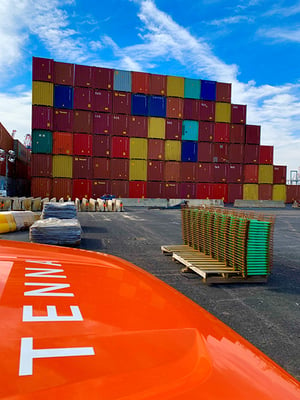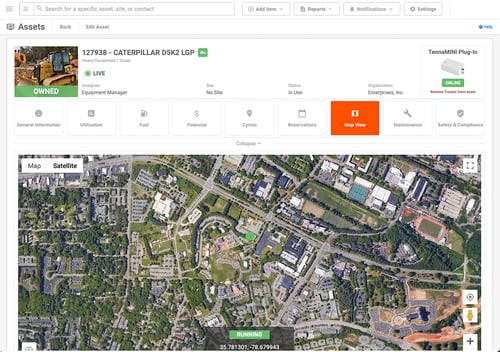
Construction supply chain disruptions have led to shortages and uncertainty for many businesses. Production in many industries was slowed or halted during the COVID-19 pandemic and are still operating below pre-pandemic levels. Airline strikes, the Russia-Ukraine War and Chinese factory lockdowns have led to further shipping and supply chain delays.
Construction supply chain delays are frustrating for business owners and consumers. According to a 2021 EquipmentWatch whitepaper titled “Understanding the State of the Construction Equipment Economy,” more than half of construction businesses say they have experienced significant delays in the arrival of new equipment. People can’t get the materials or products they need, and businesses are losing money. This is especially true for the construction industry. There are increasing lead times for building materials, machinery, and fleet vehicles.
Construction technologies like IoT telematics and asset tracking devices like GPS trackers, BLE beacons and QR codes, can help you track and maintain your owned assets and access helpful information from them. Fortunately, you can take these steps to minimize the impact construction supply chain disruptions have on your business.

1. Use Domestic Suppliers
It can take two or more weeks for items to arrive in the U.S. when shipped overseas. According to CNBC, only 21% of shipping vessels arrive at ports on time as of April 2022, with the majority taking longer to reach their destination. In March 2022, ships worldwide were delayed for an average of 7.26 days. Once cargo ships arrive, they face further delays as worker shortages are backlogging ports and distribution along the supply chain.
International shipping and delays at ports have been an ongoing issue since the pandemic in early 2020 and don’t look to improve any time soon. More than half of business owners have reported delays in receiving heavy equipment in the past year. Your business can shorten lead times and receive your materials and goods faster by looking for suppliers within your own country.
Domestic suppliers can typically ship materials faster than international suppliers and don’t have to go through customs processes that may tack on additional days or weeks to your delivery. With domestic suppliers, you may benefit from reduced costs, better flexibility, and more control over aspects of the shipping process.
2. Stop Ordering in Bulk
Your company may be used to ordering items in bulk quantities to save money. However, with many items in short supply now, you may be waiting longer for bulk orders to get fulfilled. Your cash flow is also affected, as money is tied up longer waiting for your shipment to arrive.
Prices for construction materials have also increased dramatically. According to the EquipmentWatch report, there has been a 45% jump in the price of lumber over the previous year. If you are still recovering from the impact of the lockdown, you may be unable to afford the higher cost of bulk orders.
Consider purchasing smaller quantities of the materials or products you need more frequently instead, which may prove more economical during this period. This helps suppliers finalize and ship orders to you faster. You’ll also save money by using the quantity purchased immediately instead of paying for storage and taking hits to your productivity with jobsite delays which are highly costly in the long run.
Use your historic utilization data and library bids to determine how much you have used for similar scopes in the past so you know how much you need to order and how frequently shipments should arrive to fulfill your critical path work items.
3. Keep Inventory on Standby
Even if you’re not buying bulk, keeping extra inventory on hand is still a good idea. Keeping a small number of essential supplies on standby is smart, especially if you know they’re popular products vulnerable to supply chain disruptions or shortages. You don’t want to be caught empty-handed or be unable to do your work if one or two materials are suddenly unavailable.
Successful inventory management requires you to be diligent in ordering, storing, selling, and tracking your stock levels. To reduce the impact of supply chain shortages, try to prevent out-of-stock issues by retaining a high quantity of your most popular products or pieces of equipment.
According to the EquipmentWatch industry whitepaper, 40% of equipment owners reported renting additional equipment because they needed it for immediate use and couldn't wait for supplies. To see what aspects of your inventory are in high demand, use software that collates your fleet data on an easy-to-navigate dashboard. Generate reports and analytics based on insights about your business’ performance to improve your equipment management, make smarter decisions, and forecast future trends.
4. Maximize the Life of Your Fleet
Construction equipment and vehicles are expensive investments. Your construction company relies on these machines to complete their projects and turn a profit. Delays in shipping aren’t just affecting the materials you need; they’re impacting the availability of construction equipment and vehicles you need in your fleet.
One-third of equipment owners are keeping their fleet for longer, according to the industry report. You can reduce the shortage’s impact on your business by conducting regular fleet and construction equipment maintenance.
Proper maintenance is crucial to the lifespan of your fleet. EquipmentWatch reports that 32% of equipment owners find tracking and monitoring maintenance events their biggest challenge. Equipment maintenance software ensures your equipment is maintained regularly.
Routine fleet maintenance ensures your vehicles are operating at their peak performance and can extend the vehicle’s life, saving your company money over the long-term. Maintaining your construction equipment is just as important. With shortages and delays in construction equipment, broken down vehicles and machinery can halt projects for months, and it is wise to optimize the fleet assets you already own.
5. Keep Track of All Your Assets
With asset tracking technology, you can keep an accurate visibility of large assets as well as tools, parts, and materials. You can track your assets using multiple types of trackers and technologies on an app or website. This saves your company time by not having to account for every piece of inventory manually.

Asset tracking technology also helps manage your equipment by collecting asset details and history. You can see when assets are being under or over-utilized so you can make informed maintenance and replacement choices. Asset tracking platforms like Tenna may also allow you to reserve assets for future projects to prevent delays and set up automatic asset transfers across job sites.
A common asset tracking method is using telematic GPS tracking systems for your vehicle fleets. GPS asset trackers also help you keep track of your expensive construction equipment and assist with overall fleet management when paired with a construction-focused equipment fleet management platform.
GPS tracking systems enable your business to monitor and track data about the use of your equipment. The data states that 50% of construction companies cite their reason for keeping their equipment longer is due to uncertainty in the supply chain. Knowing where and how equipment is being used and its condition can help save your business money. It also allows you to adjust and better allocate resources when supply chain delays occur.
Equipment tracking software is essential if you’re managing multiple job sites. It helps you manage and operate your construction equipment, track data on how it’s being used, and help find the best ways to optimize its use.
Using data-driven tracking technologies can help your construction business overcome supply chain delays by using your equipment more efficiently.
6. Have a Backup Plan
Creating a backup or emergency plan allows your business to know what steps to take when problems occur. If you don’t already have one, create a backup plan to deal with supply chain shortages and delays. Communicate with your suppliers to know what options you have ahead of time if certain items are in short supply or heavy demand.
87% of equipment owners are planning to purchase new equipment over the next year, according to EquipmentWatch. Increased demand and supply chain delays make it harder to purchase new equipment. Consider renting heavy equipment instead of dealing with the delays of purchasing new items. You’ll be able to complete projects faster by not having to wait for shipping delays.
Understand which supplies are essential and have the biggest negative effect on your company if delayed. You can use this information to build up your emergency inventory or find alternative supply routes.
Identify other suppliers in your region or industry to use when your primary supplier is out of stock, or the lead times become too long. Having plans in place and adjusting quickly can help reduce the impact of supply chain delays on your business.
How Tenna Can Help
![]() Disruptions to the supply chain occur when there are natural disasters, global/political events, shipping backlogs, and fluctuations in supply. You may feel like you have little control over supply chain delays, but there are steps your business can take to lessen the effects of delays on your bottom line.
Disruptions to the supply chain occur when there are natural disasters, global/political events, shipping backlogs, and fluctuations in supply. You may feel like you have little control over supply chain delays, but there are steps your business can take to lessen the effects of delays on your bottom line.
Consider products and services from Tenna to help your business better handle supply chain disruptions. Our construction asset management software allows you to track and operate your fleet at optimal performance and efficiency. It gives you more control over all aspects of your equipment management for your current assets and lets you anticipate and prepare for supply chain delays.
About Russ Young
As Chief Business Development Officer for Tenna, Russ oversees the growth strategy for the organization by working with sales, partners and customers to ensure success. Russ brings two and a half decades of experience from Google, Amazon, Oracle and FMI in best practices for technology strategy, selection and adoption. He applies his knowledge from these organizations to build awareness and provide thought leadership to the construction industry. He emphasizes the importance of technology and picking the right tool for the job.

